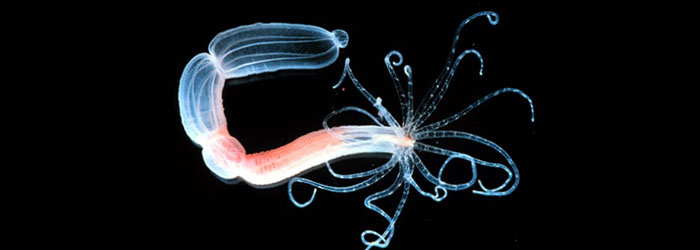Earthquake Model Explains Hydra's Regenerative Prowess

Hydra is a genus of simple fresh-water animal possessing radial symmetry.
doe.gov
(ISNS) -- When the Greek hero Hercules sliced through one of the Lernaean Hydra's nine heads, two grew back in its place. This mythical creature's real life counterparts, a genus of tiny cylindrical animals known as Hydra, have equally impressive regenerative powers, prompting physicists to adapt a computer model to unlock these animals' secrets.
Chop off a real Hydra's head and foot, and only a spherical soup of cells from the animal's midsection will remain. But the Hydra isn't dead; over the course of several days, the Hydra will form a new head, tentacles and foot from this small grouping of stem-cell like body cells and return to its tube-like shape.
"You haven't stripped [the Hydra] down or busted it up," said Rob Steele, a biologist specializing in Hydra at the University of California Irvine who was not involved with the latest research. "You're just watching it go about its business."
This resiliency has captivated biologists and physicists alike, and scientists hope to gain new insights into how more complex animals develop by studying Hydra. Now a group of Italian researchers has used computer models originally applied to the study of earthquakes to better understand this regenerative ability.
For the latest research, a group led by Andrea Gamba, a physicist specializing in quantitative biology from the Polytechnic University of Turin in Italy, developed a simple model based on a Hydra-specific gene called ks1. In the earthquake model, energy accumulates under the Earth's surface until an energy threshold is reached, releasing the energy to surrounding regions. Similarly, Gamba and his colleagues used the model to describe how cells spread the ks1 gene's message.
"You have several cells that communicate between each other in bursts of activity," said Gamba. "Each cell produces the message, and this is passed to the neighbors once some threshold is reached."
Gamba's model shows that when cells reach their individual thresholds of a gene promoting factor, they pass along the message encoded in the ks1 gene, increasing the likelihood that a head will form. Once enough cells express this gene, a Hydra will start to re-form its cylindrical shape, and head-specific cells will develop.
"The ks1 gene tells them which cells are on their way to becoming cells of the head," said Steele.
While the ks1 gene indicates that cells will differentiate into other specialized cells -- such as head cells -- it does not control the process, according to Steele. Consequently, Gamba and his team hope that this research will help biologists target the underlying source that drives the proliferation of this gene and subsequent regeneration of the head and foot.
"I think our model should prompt people to look into the biochemistry of message passing in the system," said Gamba.
However, there's no clear way to experimentally examine the promoting factor that spreads the ks1 gene, said Steele.
Nonetheless, Steele thinks that one surprising prediction from the model was worth further exploration. Previously, Gamba’s collaborators observed that Hydra heads in the lab tend to form on either cool or warm sides of their environment. In fact, the Hydra's cylindrical body aligned with the changing temperature, with the head forming with equal probability on either the warm or cool side.
"It's one of those simple profound findings," said Steele. "It's not something anyone would have predicted."
The team's model was able to replicate this observation, and that lends more credence to the underlying theory, according to Gamba.
Hydra modelers have strived to match similar biological observations in the past, and biologists and physicists have benefited from the other's contributions. Steele believes that although these two groups have diverged in the past, future research between these two groups should be symbiotic.
Both Steele and Hans Meinhardt, a physicist from the Max Planck Institute of Developmental Biology in Germany, who is credited with co-founding the field of Hydra modeling, agree that researchers still know very little about some aspects of these creatures.
For example, nobody knows how Hydras determine their tube-like body shape, said Meinhardt. Also, Steele noted that studying Hydra's nervous system may lead to a better understanding of higher organisms.
"There's no brain, no sort of central processing unit, but it's got a real nervous system," said Steele. "I'd love to know more about it in all kinds of ways."
The research from Gamba's team recently appeared in Physical Review Letters.
Brian Jacobsmeyer is a contributing writer to Inside Science News Service
